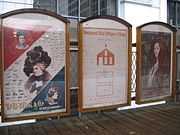Quincy (CTA station)
| ||||||||||||||||||||||||
|---|---|---|---|---|---|---|---|---|---|---|---|---|---|---|---|---|---|---|---|---|---|---|---|---|
 | ||||||||||||||||||||||||
| Station statistics | ||||||||||||||||||||||||
| Address |
220 South Wells Street, Chicago, Illinois 60606 | |||||||||||||||||||||||
| Coordinates | 41°52′44″N 87°38′01″W / 41.878752°N 87.633703°W | |||||||||||||||||||||||
| Line(s) | ||||||||||||||||||||||||
| Connections |
Union Station (3 blocks west) CTA Buses | |||||||||||||||||||||||
| Structure type | Elevated | |||||||||||||||||||||||
| Platforms | 2 Side platforms | |||||||||||||||||||||||
| Tracks | 2 | |||||||||||||||||||||||
| Other information | ||||||||||||||||||||||||
| Opened | October 3, 1897 | |||||||||||||||||||||||
| Rebuilt | 1985–1988 (Historic Restoration) | |||||||||||||||||||||||
| Owned by | Chicago Transit Authority | |||||||||||||||||||||||
| Formerly | Quincy/Wells | |||||||||||||||||||||||
| Traffic | ||||||||||||||||||||||||
| Passengers (2012) | 2,213,125 | |||||||||||||||||||||||
| Services | ||||||||||||||||||||||||
| ||||||||||||||||||||||||
Quincy is a rapid transit station on the Chicago Transit Authority's 'L' system. It is situated between the Washington/Wells and LaSalle/Van Buren stations on the Loop. The station is located above the intersection of Quincy Street and Wells Street in Downtown Chicago, Illinois. Having opened in 1897, it is one of the oldest surviving stations on the 'L' system.
Station layout
| P Platform level |
Side platform, doors will open on the right | |
| Clockwise | ← Purple Line toward Linden weekday rush hours only (Washington/Wells) ← Pink Line toward 54th/Cermak (Washington/Wells) ← Orange Line toward Midway (Washington/Wells) | |
| Counterclockwise | → Brown Line toward Kimball (LaSalle/Van Buren) → | |
| Side platform, doors will open on the right | ||
| G | Street level | Entrance/Exit |
History
Designed by Alfred M. Hedley from wood and stamped metal, Quincy opened on October 3, 1897, it retained much of its original decor over the years and was restored in 1985–1988, so that it is considered one of "150 great places in Illinois" by the American Institute of Architects.[1] The station is situated in the South Loop Financial District and is the closest CTA rail station to the Willis Tower, approximately one block west. It is also close to Union Station, the terminal for several Metra and Amtrak routes and about three blocks west of Quincy, although the Clinton station on the Blue Line is closer.
Quincy is an elevated station, situated above Quincy Street between Adams Street and Jackson Boulevard. It features two side platforms and station houses, one on the west to serve the Outer Loop track, and one on the east to serve the Inner Loop track. Turnstiles for fare payment are located within the station houses on the platform level. The station once had a transfer bridge, but this was removed in the 1980s. This means it is not possible to change from one platform to the other without paying another fare or asking for employee assistance. There are auxiliary rotogate exits to both Adams and Jackson on the Inner Loop platform, while the Outer Loop only has an auxiliary exit to Adams. Both platforms are designed to handle eight-car trains, the longest the CTA 'L' system can run.
Prior to September 1953, the station also featured a walkway to the Wells Street Terminal for convenient transfers to interurban trains of the Chicago Aurora and Elgin Railroad.
In the 1980s, Quincy was restored to an appearance much as it would have looked when it opened. Some materials, such as signage, were reproduced although several of the station's features are original to its 1897 opening.
Services
Quincy serves the Brown Line (which goes counterclockwise on the Outer Loop track), the Orange, and Pink Lines (which go clockwise on the Inner Loop track). During weekday rush hours, Purple Line Express trains share the Inner Loop platform with the Pink and Orange Lines.
In addition to 'L' trains, the station provides service to several CTA bus routes: the #1 Bronzeville/Union Station, #7 Harrison, #37 Sedgwick, #28 Stony Island, #126 Jackson, #134 Stockton/LaSalle Express, #135 Clarendon/LaSalle Express, #136 Sheridan/LaSalle Express, #151 Sheridan, and #156 LaSalle.



References
- ↑ "Loop Elevated - Quincy Station". American Institute of Architects. Retrieved 2007-06-13.
External links
| Wikimedia Commons has media related to Quincy (CTA). |
- Historic American Engineering Record (HAER) No. IL-1-A, "Union Elevated Railroad, Quincy Street Station"
- Quincy/Wells Station Page at Chicago-'L'.org
- Ridership figures, 2009 PDF (172 KiB)
- Adams Street entrance from Google Maps Street View
- Quincy Street entrance from Google Maps Street View
- Jackson Boulevard entrance from Google Maps Street View